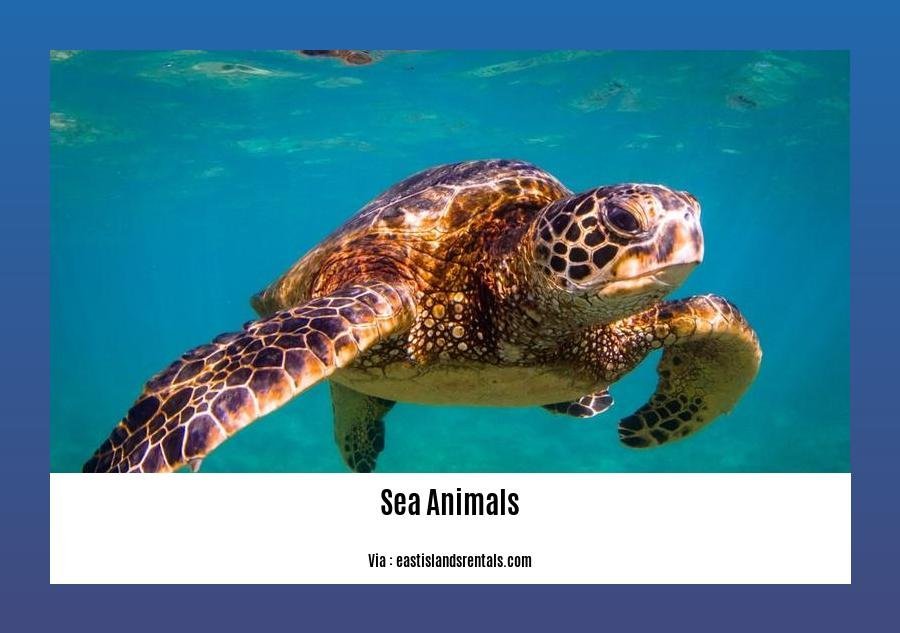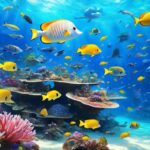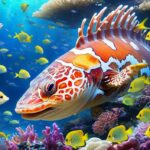Get ready to dive into the fascinating world of sea animals as we explore the depths and uncover some truly cool facts. From the mysterious and mesmerizing creatures that inhabit the darkest corners of the ocean to the playful and intelligent beings that grace our shores, this article will take you on an unforgettable journey. Join us as we marvel at the unique adaptations, intriguing behaviors, and ecological importance of these amazing creatures. Brace yourself for a deep dive into the awe-inspiring world of sea animals!
Key Takeaways:
– Seahorses are the only animals in which the males give birth and take care of their young.
– Shrimps have their hearts located in their heads, showcasing the diverse anatomy of sea animals.
– Sea sponges, despite lacking vital organs like a head, mouth, eyes, and brain, are alive and adapt to their marine environment.
– Turtles can be found on every continent except Antarctica and have coexisted with dinosaurs.
– Blue whales are the largest sea mammals and the largest known animals in the world.
– Sea turtles have thrived since the time of dinosaurs, adapting to changing environments.
– Some species of sharks, like the great white shark, are warm-blooded, which enhances their agility and hunting efficiency.
– Sea lions, seals, and walruses, known as pinnipeds, have winged feet adapted for swimming.
– Dolphins possess excellent hearing and vision, allowing them to navigate, communicate, and locate prey.
– Whales communicate through singing, which serves various purposes within their pods.
– Sharks have an exceptional sense of smell, capable of detecting small amounts of blood in vast amounts of water.
– The giant crab of Japan is a fascinating sea creature known for its enormous size.
Cool Facts About Sea Animals
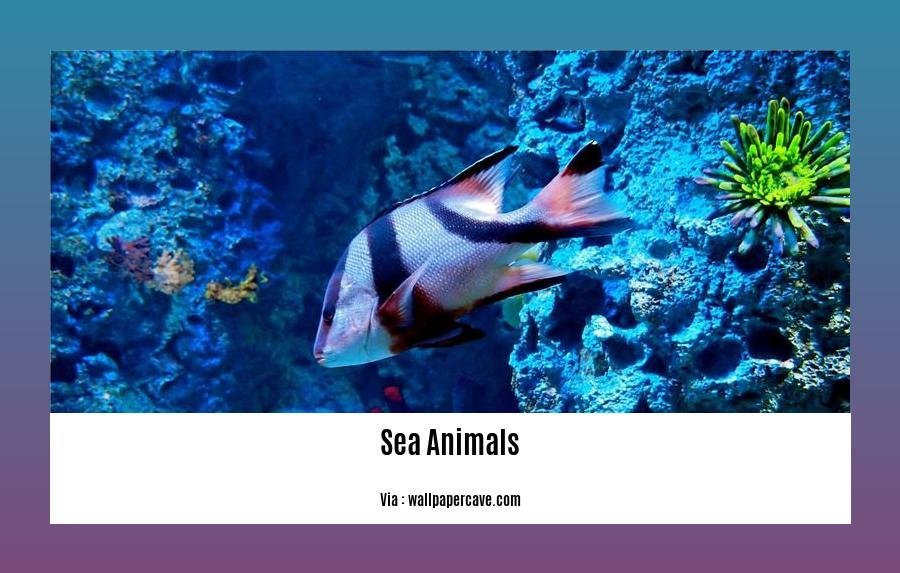
Male Seahorses and Their Unique Parenting Role
- Cool Fact: Seahorses are the only animals in which the male, not the female, gives birth and takes care of their young.
- These fascinating creatures have evolved a pouch where they incubate and nourish their offspring until they are ready to be released into the world.
- The male seahorse’s commitment to parenting is truly remarkable, showcasing the diversity of reproductive strategies in the animal kingdom.
Surprising Anatomy of Shrimps’ Heart
- Cool Fact: Did you know that a shrimp’s heart is located in its head? It might be difficult to imagine, but this fun fact about shrimps highlights the incredible diversity of animal anatomy.
- This unique adaptation allows shrimps to efficiently pump blood and distribute oxygen throughout their bodies.
Sea Sponges: A Living Paradox
- Cool Fact: Sea sponges, despite their lack of vital organs like a head, mouth, eyes, and brain, are alive.
- These humble creatures possess no bones, heart, or lungs, yet they thrive in the oceanic environment.
- Sea sponges rely on the water currents to bring them nutrients and oxygen, showcasing their ability to adapt and survive in unique ways.
Global Presence of Turtles
- Cool Fact: Turtles can be found on every continent except Antarctica.
- These ancient creatures have inhabited the Earth for millions of years, coexisting with dinosaurs.
- Their ability to adapt and thrive in various environments is a testament to their resilience and evolutionary success.
The Enormous Blue Whale: The Largest Sea Mammal
- Cool Fact: The blue whale holds the title for being the largest sea mammal as well as the largest known animal in the world.
- These majestic creatures can reach lengths of up to 100 feet and weigh more than 200 tons.
- The awe-inspiring size of blue whales showcases the incredible diversity and grandeur of marine life.
Ancient Survivors: Sea Turtles and Dinosaurs
- Cool Fact: Since the time of dinosaurs, sea turtles have been alive and thriving on our planet.
- These magnificent creatures have stood the test of time, adapting to changing environments and remaining an essential part of marine ecosystems.
Warm-Blooded Sharks and Their Exceptional Traits
- Cool Fact: While most sharks are known to be cold-blooded, some species, like the great white shark, are warm-blooded.
- This unique characteristic allows these apex predators to maintain a higher body temperature than the water they inhabit, providing them with enhanced agility and hunting efficiency.
Pinnipeds: A Group of Winged-Footed Marine Mammals
- Cool Fact: Sea lions, seals, and walruses are collectively known as pinnipeds due to their winged feet, which are adapted for swimming and maneuvering in the water.
- These incredible creatures are well-suited for their aquatic lifestyle and display remarkable agility both underwater and on land.
Sensory Abilities of Dolphins
- Cool Fact: Dolphins, known for their intelligence, possess excellent hearing and vision.
- These sensory abilities enable them to navigate through their marine environment with precision, communicate with one another, and locate prey.
- Dolphins’ remarkable sensory capabilities contribute to their social behaviors and group dynamics.
Whales’ Melodic Communication
- Cool Fact: Whales, another group of marine mammals, communicate through a melodious phenomenon known as singing.
- These enchanting songs serve various purposes, including mating displays, locating one another, and establishing social connections within their pods.
- Whales’ unique form of communication adds to the intrigue and wonder surrounding these mysterious creatures.
Sharks’ Unmatched Sense of Smell
- Cool Fact: Sharks have an extraordinary sense of smell, capable of detecting one part of blood in 100 million parts of water.
- This keen olfactory sense allows sharks to navigate vast oceanic territories, locate potential prey, and find mates.
- Their ability to detect scent trails from great distances is a testament to their remarkable sensory adaptations.
Gigantic Crab of Japan
- Cool Fact: The giant crab of Japan is a fascinating sea creature that can grow as large as 12 feet across.
- These colossal crustaceans captivate the imagination with their enormous size and unique appearance.
Exploring the wonders of sea animals broadens our understanding of the natural world and inspires us to protect and preserve these magnificent creatures and their habitats. From the amazing reproductive traits of seahorses to the sensory capabilities of dolphins and the sheer grandeur of blue whales, sea animals never fail to mesmerize us with their extraordinary characteristics. Their ability to adapt to various environments and thrive in the vast expanses of our oceans is a testament to the richness and diversity of marine life.
Check out some cool facts about Quebec! You won’t believe what this fascinating Canadian province has to offer.
Discover intriguing information about Vatican City and be amazed by its rich history and cultural heritage.
Learn all about the remarkable world of veterinarians and their valuable contributions in caring for animals. It’s truly awe-inspiring!
The Astonishing Abilities of Octopuses
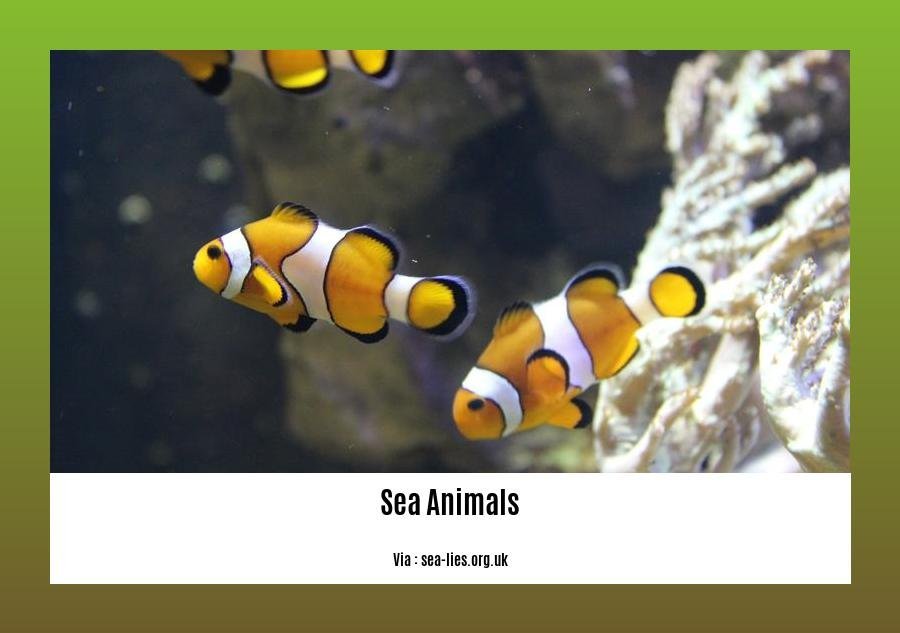
Octopuses, those elusive creatures of the sea, possess a plethora of astonishing abilities that make them truly unique. These masters of disguise and problem-solving have captivated scientists and enthusiasts alike. Let’s dive into the fascinating world of octopuses and uncover their astonishing abilities.
1. Masters of Disguise
Octopuses are true masters of camouflage. They have the incredible ability to change their color, texture, and shape, allowing them to blend seamlessly into their surroundings. By adjusting their pigmented skin cells known as chromatophores, they can mimic the colors and patterns of their environment. It’s their own form of underwater magic!
2. Escape Artists Extraordinaire
When faced with danger, octopuses have an uncanny knack for escaping seemingly impossible situations. Their soft and flexible bodies allow them to squeeze through tiny openings, and their boneless structure enables them to contort themselves in ways you wouldn’t believe. Imagine an octopus slipping out of a jar with a narrow mouth, leaving even the most skilled escape artists in awe.
3. Exceptional Problem Solvers
Octopuses possess impressive problem-solving skills. They can navigate mazes, open jars to access hidden treats, and even dismantle complicated mechanisms. One study observed an octopus unscrewing a jar from the inside to reach a tasty reward. Their ability to think critically and find innovative solutions showcases their intelligence and adaptability.
4. Inquisitive Minds
Curiosity is inherent in these remarkable creatures. Octopuses show a strong appetite for exploration, often investigating objects and their surroundings. They have even been observed playing with toys, showing an active and playful nature. Their curiosity drives them to continuously learn and discover, making them fascinating subjects for scientific study.
5. Shape-shifters
Octopuses take shape-shifting to a whole new level. They can elongate their bodies, flatten themselves to appear like a piece of coral, or even adopt the shape of other sea creatures. This remarkable ability allows them to hide in plain sight and avoid detection by predators or prey. Imagine being able to become anyone or anything you want in an instant!
6. Intelligent Communicators
Communication among octopuses is a fascinating and complex realm. Through the use of body postures, color changes, and movements, octopuses convey intricate messages to one another. They can communicate aggression, courtship, and even indicate their intentions. Their language may be alien to us, but it’s a captivating dance of signals in the underwater world.
These astonishing abilities truly set octopuses apart from other sea creatures. Their intelligence, adaptability, and diverse range of skills make them an endless source of fascination and wonder. So let’s dive deeper into the enigmatic world of these eight-armed wonders and unravel even more about their astonishing abilities!
Key Takeaways:
- Octopuses possess incredible camouflage skills, allowing them to blend seamlessly into their surroundings.
- They are notorious for their exceptional problem-solving abilities, navigating mazes and unlocking hidden treats.
- These creatures are true escape artists, able to squeeze through tiny openings and contort their flexible bodies.
- Octopuses exhibit a remarkable level of curiosity, actively exploring their environment and even playing with toys.
- Their shape-shifting abilities enable them to take on different forms, allowing them to hide or imitate other creatures.
- Communication among octopuses is intricate, with body postures, color changes, and movements conveying complex messages.
Sources:
– National Geographic
– The Conversation
Fascinating communication methods among dolphins
Dolphins, those playful and intelligent creatures of the sea, have always captured our curiosity. One aspect that particularly fascinates researchers and enthusiasts alike is their unique communication methods. Dolphins communicate through whistles, clicks, and echolocation, making for a diverse and intriguing language unlike any other in the animal kingdom.
Whistles play a significant role in dolphin communication. Every dolphin has its own signature whistle, similar to a human name. This whistle acts as a vocal identity, allowing dolphins to recognize each other and maintain social bonds within their pods. It’s like having a personalized name tag for dolphins!
But they don’t stop at whistles. Dolphins also use clicks for sonar, allowing them to navigate their environment and locate prey. These extraordinary creatures can produce about 700 clicking sounds per second, providing them with incredibly precise sonar abilities. These clicks originate from deep inside their heads, just beneath the blowhole.
What’s truly remarkable is that dolphins can simultaneously produce whistles for communication and clicks for sonar. This multitasking ability showcases just how sophisticated their communication methods are. It’s like talking to a friend while using your smartphone’s GPS navigation system, all at the same time!
Dolphins are intensely social mammals, living in pods and working together to accomplish tasks. Their communication repertoire extends beyond whistles and clicks. They also use body language and physical contact to communicate with both humans and other dolphins. Just like humans, dolphins rely on more than just words to express themselves.
Key Takeaways:
- Dolphins communicate through a combination of whistles, clicks, and echolocation.
- Each dolphin has its own unique signature whistle, serving as its vocal identity.
- Dolphins can produce about 700 clicking sounds per second for sonar.
- These clicks come from deep inside the dolphin’s head, just underneath the blowhole.
- In addition to vocalizations, dolphins also use body language and physical contact to communicate with their pod members and humans.
Sources:
– Fact Retriever: 170 Dolphin Facts That Will Amaze You
– National Geographic Kids: Secret Language of Dolphins
Unique Adaptations of Deep-Sea Creatures
The depths of the ocean are home to some of the most extraordinary and unique creatures on the planet. Deep-sea creatures have evolved incredible adaptations to thrive in the extreme conditions of their habitat. From bioluminescence to antifreeze proteins, these adaptations enable these creatures to survive and flourish in the deep-sea environment. Let’s explore some fascinating facts about the unique adaptations of deep-sea creatures.
1. Bioluminescence: Illuminating the Dark
Deep-sea creatures have a remarkable adaptation called bioluminescence, which allows them to produce their own light. This adaptation serves various purposes, such as communication, attracting prey, or confusing predators. Bioluminescence is truly a mesmerizing phenomenon that helps deep-sea creatures navigate and survive in the depths of the ocean. [^1^]
2. Reduced or Absent Swim Bladders: Buoyancy in High Pressure
Unlike their shallow-water relatives, deep-sea creatures often have reduced or no swim bladders. Swim bladders are organs that help regulate buoyancy in fish. In the high-pressure environment of the deep sea, these adaptations are unnecessary. Without swim bladders, deep-sea creatures can better withstand the crushing depths of their habitat. [^1^]
3. Big Eyes with Enhanced Vision: Seeing in the Darkness
Adapted to the perpetual darkness of the deep sea, many deep-sea creatures have large eyes with a greater number of cones. This adaptation allows them to have improved vision and see in the dark. With their keen eyesight, they can spot prey, navigate their surroundings, and avoid potential threats in the deep, dark abyss. [^1^]
4. Reduced Pigmentation: Blending with the Darkness
The lack of light in the deep-sea environment has led to an intriguing adaptation – reduced pigmentation. Deep-sea creatures often have pale or transparent bodies to camouflage themselves and blend with their surroundings. This adaptation enables them to hide from predators and reduces their visibility in the vast darkness of the deep ocean. [^1^]
5. Squishy Bodies: Endurance in High Pressure
The extreme pressure in the deep sea is enough to crush most organisms. Deep-sea creatures, however, have adapted with squishy bodies that can withstand these immense pressures. Their flexible and gelatinous bodies enable them to survive in this harsh environment, where the pressure can be hundreds of times greater than at the surface. [^1^]
6. Deep-Sea Gigantism: Size Matters in the Depths
One striking phenomenon in the deep-sea realm is deep-sea gigantism. Many deep-sea creatures tend to be larger in size compared to their shallow-water counterparts. This adaptation allows them to survive in a resource-scarce environment and enhances their chances of finding food and mates. From colossal squids to giant isopods, the deep sea is home to colossal wonders. [^1^]
7. Antifreeze Proteins: Surviving Extreme Cold
Deep-sea creatures have developed a fascinating adaptation to survive in the freezing temperatures of the deep ocean. They produce antifreeze proteins that prevent their body fluids from freezing. This adaptation enables them to thrive in the frigid waters and withstand the bone-chilling conditions of their deep-sea habitat. [^1^]
8. Wider Mouths and Elastic Jaws: Devouring Large Prey
In the deep-sea world, where resources are scarce, some creatures have adapted with wider mouths and elastic jaws. These adaptations allow them to consume larger prey, which may be essential for their survival in such an environment. By having the ability to feed on bigger prey, they increase their chances of obtaining the necessary nourishment in the deep ocean depths. [^1^]
Deep-sea creatures have truly evolved remarkable adaptations to thrive in their dark, cold, and high-pressure environment. Through bioluminescence, enhanced vision, and other incredible adaptations, they have conquered the challenges of the deep sea. These unique adaptations enable them to navigate, communicate, and survive in a world that remains largely unexplored.
Key Takeaways:
- Deep-sea creatures possess unique adaptations to survive in the extreme conditions of the deep ocean.
- Bioluminescence is a common adaptation that allows deep-sea creatures to produce their own light.
- Deep-sea creatures often have reduced or no swim bladders, as they don’t need to regulate buoyancy in the high-pressure environment.
- Big eyes with enhanced vision help deep-sea creatures see in the darkness and navigate their surroundings.
- Reduced pigmentation allows deep-sea creatures to blend with the darkness and hide from predators.
- Squishy bodies enable deep-sea creatures to endure the high pressures of their habitat.
- Deep-sea gigantism is a phenomenon where deep-sea creatures tend to be larger in size compared to their shallow-water relatives.
- Antifreeze proteins help deep-sea creatures survive in the extremely cold temperatures of the deep ocean.
- Wider mouths and elastic jaws are common adaptations in deep-sea creatures, allowing them to consume larger prey.
Sources:
[^1^]: Nature Roamer: Deep-Sea Creatures & Their Unique Adaptations
FAQ
Q1: Why are seahorses unique in their parenting role?
A1: Seahorses are unique because the male, not the female, gives birth and takes care of their young. They have evolved a pouch where they incubate and nourish their offspring until they are ready to be released into the world.
Q2: Where is a shrimp’s heart located?
A2: Surprisingly, a shrimp’s heart is located in its head. This unique adaptation allows shrimps to efficiently pump blood and distribute oxygen throughout their bodies.
Q3: How do sea sponges survive without vital organs?
A3: Sea sponges may lack vital organs like a head, mouth, eyes, and brain, but they are alive. They rely on water currents to bring them nutrients and oxygen, showcasing their ability to adapt and survive in unique ways.
Q4: How big can the giant crab of Japan grow?
A4: The giant crab of Japan can grow as large as 12 feet across. These colossal crustaceans captivate the imagination with their enormous size and unique appearance.
Q5: How do dolphins communicate and navigate?
A5: Dolphins communicate through a variety of sounds, including whistles, clicks, and echolocation. They can produce whistles for communication and clicks for sonar at the same time. Dolphins also use body language, physical contact, and their excellent hearing and vision to navigate through their marine environment with precision.
